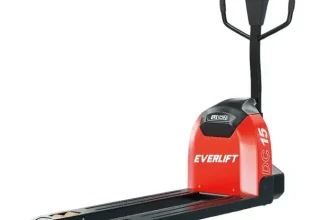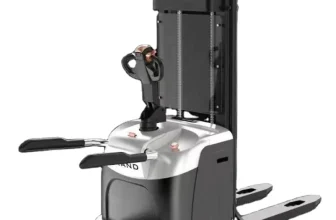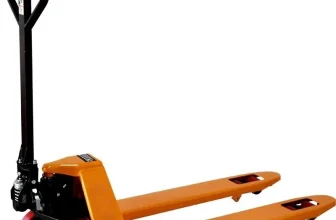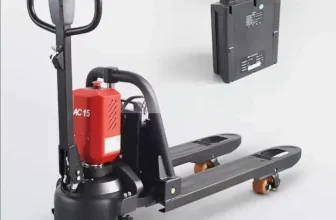With their lightweight size and hauling capability, pallet jacks are generally used in warehousing operations to move pallets of goods between locations.
There are many different kind of pallet jacks, ranging from the manual to the fully electric.
This article will tell you everything you need to know about pallet jacks, what they are used for, the different types, and how to stay safe when operating a pallet jack.
What is a Pallet Jack?
A pallet jack, also known as a pallet truck or a pallet pump, is a basic type of forklift used primarily in warehouses to move pallets of goods from one location to another.
Pallet jacks are highly efficient, and save time and manpower by turning a strenuous, multiple-person job into a simple task suited for one person.
While there are different types of pallet jacks, most share the same basic parts.
- Control lever
- Handle
- Hydraulic pump
- Steer wheels
- Load wheels
- Forks
Standard jacks are designed to carry and move a 40″ x 48″ inch pallet, due to the size of the forks and placement of the load wheels.
The max lifting capacity for a standard, manual pallet jack is between 3000 and 5500 pounds.
However, while these are the standard jacks, there are many designed to carry smaller or larger loads.
What are Pallet Jacks Used For?
Typically used in warehousing environments, pallet jacks are used to haul pallets and palletized loads.
They are ideal for moving heavy loads short distances.
Some types of pallet jacks can also be used for hauling furniture, large appliances, and heavy boxes.
Who Needs a Pallet Jack?
Anyone who works in a warehousing environment likely uses pallet jacks on a regular basis.
Other industries that use pallet jacks are:
- Landscaping companies
- Furniture/appliance retail centers
- Manufacturers
- Automotive
- Food and beverage
- Iron and steel manufacturers
- Paper manufacturers and retailers
- Ports
- Steel plants
- Lumber companies
Pallet jacks that are used in facilities where there is a lot of water or corrosive chemicals present can be made with corrosive-resistant materials.
Corrosive-resistant pallet jacks are generally used in facilities such as ports or lumber companies, or industries that work with fish, meat, and poultry, as the pallet jacks are designed to resist rust in wet environments.
While pallet jacks are used primarily in the above industries, they are available for purchase and use for the public.
Anyone can purchase a pallet jack for their personal use, though there is little reason to do so unless you work with heavy loads such as pallets.
How Much do Pallet Jacks Cost?
Manual pallet jacks usually start at a price point around $400, while $4500 is the low end for an electric pallet jack.
High lift pallet jacks are more expensive than manual pallet jacks, and riding pallet jacks usually cost more than electric pallet jacks.
Size and capability affect the price for any type of pallet jack, with electric ones costing the most.
The Different Types of Pallet Jacks
While the term “pallet jack” usually evokes images of the standard pallet jack, there are many different kinds of pallet jacks with various purposes.
Depending upon your industrial needs, you may need a different pallet jack than the standard manual ones.
Manual Pallet Jack
The manual pallet jack is the most widely used and purchased, with the basic parts as follows:
- Control lever (also known as a “tiller”) – used for moving, lifting, and lowering pallet jack.
- Raised position: lift cylinder and forks lower, releasing pallet
- Lowered position: when in this position, lowering the handle raises the forks
- Handle – used for changing direction in steering pallet jack by releasing the hydraulic fluid
- Hydraulic pump – converts mechanical power into hydraulic energy
- Steer wheels – wheels for steering pallet jack
- Load wheels – situated under the forks, used for supporting the pallet’s weight
- Forks – connected at base of the jack, the forks insert below the pallet.
As mentioned above, manual pallet jacks are suited for standard 40″ x 48″ pallets.
The maximum load capacities are between 3000 and 5500 pounds.
Money-wise, they are priced lower than any other kind of pallet jack.
While manual pallet jacks come in a variety of colors, sizes, and brands, they have the same parts and function – to haul pallets and palletized loads short distances, usually within a warehouse setting.
Important note: when operating a manual pallet jack, always try to push the load whenever possible.
Pulling the load strains your back muscles and can result in severe back injuries.
Pushing the load keeps your spine straight and allows you to use the large muscles in your legs to bear the burden.
When Should I Use Manual Pallet Jack?
You should use a manual pallet jack anywhere you need to haul heavy, palletized loads short distances.
They are used to organize loads inside a trailer or other small spaces for various purposes.
Manual pallet jacks are designed to be used on flat, smooth surfaces, such as concrete or tile floors, as the forks are just high enough to clear the floor.
They are easier to maneuver in small, tight spaces, unlike forklifts.
Manual pallet jacks are unsuited for outdoors or any other uneven terrain.
Pros and Cons of Manual Pallet Jacks
Pros
- Cost – initial cost of the pallet jack and the cost of maintenance are both low\
- Design – basic design is compatible with a wide range of pallets and loads
- Training – very little training is required to operate a pallet jack
Cons
- Distance – unsuited for large warehouses or long distances
- Injuries – injuries, especially back injuries, are more common with manual pallet jacks than with their electric counterparts
- Load size – limited by how much the person operating the pallet jack can handle
Electric Pallet Jack
The main difference between a manual pallet jack and an electric pallet jack is that the electric models utilize a motor to raise and lower the forks and propel the jack.
Because of the motor, the forks can be raised higher than they would be on a manual jack.
Electric pallet jacks have batteries that require charging, but the batteries typically last several hours before needing to be recharged.
Riding pallet jacks are a type of electric jack, but we’ll learn more about riding pallet jacks later in this article.
When Should an Electric Pallet Jack?
Electric pallet jacks are most often used in construction sites, automotive environments, or in other large facilities where heavy loads have to be moved longer distances that could be physically taxing for employees to haul with manual pallet jacks.
They are more versatile than forklifts and are ideal in environments unsuited for forklifts, such as supermarkets, cargo containers, and narrow aisles.
Electric pallet jacks have max load capacities of between 2000 and 6000 pounds for the basic models, making them generally capable of handling heavier loads than manual pallet jacks.
Important note: depending on where you live, a license may be required to operate an electric pallet jack.
Even in states where you don’t need a license, training is still required to operate an electric jack.
Pros and Cons of Electric Pallet Jacks
Pros
- Fewer injuries – less strain on the person operating the jack
- Increased productivity – this is especially true in large facilities when loads have to be moved greater distances
- Stacks – better for moving tall pallet stacks
- Safety – emergency stops and “dead-man’s” buttons come standard with electric pallet jacks in order to avoid accidents
Cons
- Cost – expensive to buy and to maintain
- Maintenance – electric equipment requires frequent and specialized maintenance
- Braking – takes longer for jack to come to a complete stop
- Training – special training is required to operate an electric pallet jack
- Batteries – Requires recharging
CARB Incentives
If you live in the state of California, there are special incentives you can apply for in order to offset the high cost of electric pallet jacks.
In recent years, the California Air Resources Board (CARB) has approved funding for businesses to help reduce their emissions.
This includes paying businesses to invest in electric equipment, including electric pallet jacks.
Semi-Electric Pallet Jack
The semi-electric pallet jack provides a happy medium between a manual jack and electric jack.
Lifting and lowering the forks is achieved by using a standard manual pump, but a single-speed electric motor hauls the load forward or reverse.
This reduces strain on the jack operators without having to pay the high cost of a fully electric pallet jack.
When Should I a Semi-Electric Pallet Jack?
The main advantage of a semi-electric pallet jack is its cost. They are best used in large facilities where loads have to be moved greater distances than manual pallet jacks can handle.
They reduce strain and potential back injuries for the jack operators.
Semi-electric pallet jacks are ideal for large facilities and companies who need, but can’t afford, fully electric pallet jacks.
Riding Pallet Jack
Also known as “ride on pallet jacks” and “ride on electric pallet jacks,” these electric pallet jacks have the extra component of a platform that allows the jack operator to ride along with the load.
The operator stands on the platform at the rear of the truck and mans the controls.
Many riding pallet jacks have a compactable platform, so the jack can operate as a regular electric pallet jack in more confined spaces.
When Should I Use a Riding Pallet Jack?
A riding pallet jack is ideal in large warehouses or other environments that require transporting loads longer distances than are suitable for manual pallet jacks.
Pros and Cons of a Riding Pallet Jack
Pros
- Safety – fewer injuries to the operators and safety features such as:
- emergency brakes
- “dead-man’s” buttons
- Driving – operated via steering wheel, buttons, and lever
- Height – pallets can be lifted higher off the ground
- Capacity – can carry more pallets at a time
- Vision – while standing on platform, operator can see over the pallets and avoid collisions
- Versatile – able to maneuver smaller spaces than a forklift
Cons
- Cost – expensive to purchase and to maintain; most expensive type of pallet jack
- Maintenance – requires frequent and specialized maintenance
- Batteries – Requires recharging
High Lift Pallet Jack
High lift pallet jacks are a type of manual jack that have the capability of lifting the loads high off the ground.
While manual pallet jacks account for more injuries than any other type of pallet jack, high lift jacks are safer because they perform the extra function lifting the load – further reducing potential strain on the operators’ backs.
High lift pallet jacks perform three essential functions in one piece of equipment.
They lift loads, transfer them, and lift them up to their optimal height.
The load is lifted by pumping the handle until the forks are at the required height.
In transporting loads, they operate just like standard manual pallet jacks.
When Should I Use a High Lift Pallet Jack?
High lift pallet jacks are best suited for environments when loads need to be raised or lowered, such as on shelves that are too narrow for forklifts.
They are adjustable, and provide work stations at heights that don’t cause back injuries.
Supermarkets, construction sites, distribution centers, and other environments that require shelving would benefit the most from high lift pallet jacks.
Scissor Pallet Jack
Also known as a scissor lift pallet jack, these are a form of high lift pallet jack named for the crisscrossed frame that supports the load when lifted.
Like high lift pallet jacks, they lift to the height of tables and work stations so the operator can slide loads off without lifting and potentially causing back injuries.
When Should I Use a Scissor Pallet Jack?
Any environment that needs high lift pallet jacks – such as supermarkets, distribution centers, construction sites, and other environments with shelving and narrow aisles.
Narrow Pallet Jack
As the name suggests, narrow pallet jacks are narrower versions of manual pallet jacks.
While manual pallet jacks have dimensions of 40″ x 48″, narrow pallet jacks are 20″ x 48.”
The advantages of narrow pallet jacks are their ability to fit into tight spaces.
They are also designed to easily access smaller pallets.
Contrary to how it seems, narrow pallet jacks generally have the same weight limits as manual pallet jacks.
When Should I Use a Narrow Pallet Jack?
You should use a narrow pallet jack when you have to move smaller pallets in an environment with tight spaces where standard manual jacks or other types of pallet jacks are too large or bulky for the job.
Mini Pallet Jack
A mini pallet jack, as the name suggests, is a miniature version of the standard manual pallet jack.
The forks on standard size pallet jacks are generally 27″ x 48″, while the forks on mini pallet jacks measure around 20.5″ x 24.”
When Should I Use a Mini Pallet Jack?
Mini pallet jacks are ideal for situations where small loads need to be moved short distances.
They are smaller and easier to store than standard size pallet jacks, and maneuver more easily in tight spaces.
Operating a Pallet Jack
Operating a Manual Pallet Jack
Locate the release lever (also called a control lever or a “tiller”) – usually attached to the center bar and a different color to make it stand out
Approach pallet and press lever – press lever up and inward to lower the forks to about one inch off the ground
Slide the prongs under the pallet – push prongs all the way through the underside of the pallet and make sure the wheels all touch the floor and not any part of the pallet
Raise pallet by pushing down on handle – pump the handle towards you. You’ll notice some resistance as the forks slowly lift the pallet off the floor. Pump until the forks are high enough for the pallet not to drag.
Push instead of pulling load to reduce strain on your back
Operating an Electric Pallet Jack
Unplug and store cord – you should store the charger cord anytime you are using the electric pallet jack
Find the controls and lower the prongs – instead of using a control lever, electric pallet jacks use buttons to control the direction of movement. Push “down” button to lower the forks until they’re about one inch off the ground
Load pallet – maneuver jack so forks are under the pallet. Press “up” button to raise the forks and the load
Use control buttons to move load
Plug in pallet jack when not in use so it can charge
Pallet Jack Safety Tips
The following tips help you stay safe when operating a pallet jack.
Push instead of pull the load whenever possible – pulling strains back muscles, and back injuries account for the majority of injuries caused by pallet jack use
Make sure the path is clear
Always remain alert and attentive when pushing the load – especially when using electric and riding pallet jacks, which don’t brake as quickly as manual jacks
Never use pallet jack on a slope
Never overload the pallet jack – make sure you know the max lifting capacity for your individual jack
Pallet Jack Chocks
When not in use, pallet jacks can be dangerous.
When transporting pallet jacks in a trailer or shipping container, they can roll around and damage the walls and goods if being transported alongside boxes or pallets.
Pallet jack chocks, also known as pallet truck stops (PTS), are polyurethane wedges with a V-shaped slot in them.
They are designed to lock the front steer wheels of the pallet jack, effectively keeping the entire pallet jack stationary when in transit or not in use.
Maintaining Your Pallet Jack
To keep your pallet jack in good working condition, regular maintenance is required.
Depending on whether your pallet jack is manual or electric, the type and the frequency of maintenance may differ.
Check the oil inside the hydraulic pump every six months, and change or top off the oil once a year
Lubricate bearings and axles on pallet jack monthly
Protect the wheels by regularly cleaning off dirt and debris
If forks no longer properly lower, adjust lowering valve
For electric pallet jacks – in addition to the above, have electrical parts inspected and services regularly
Final Thoughts
Pallet jacks come in many different types to suit many different applications.
Taking the time to pick the right pallet jack for your particular situation will ensure your pallet jack will be a good fit for your needs for a long time to come.







